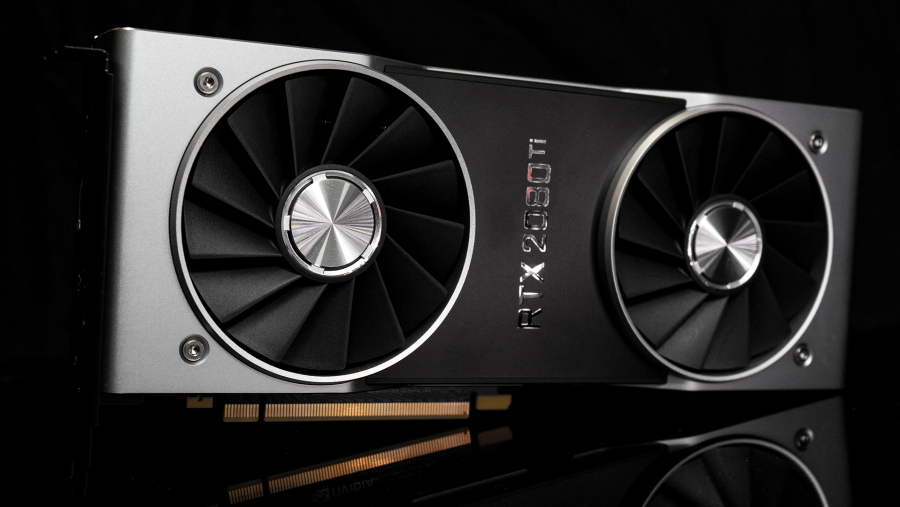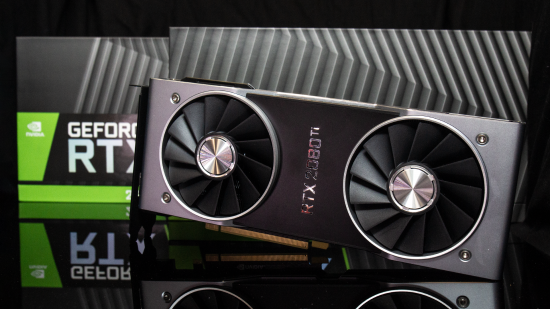The Nvidia RTX 2080 Ti and RTX 2080 are here, they’re in our hands and in the labs benchmarking away as I type. How exciting. The new cards represent the first consumer GPUs of the Nvidia Turing generation and the first genuinely new GeForce cards to drop in around 18 months.
That’s a long time in the graphics card market, but these have been pretty frickin’ barren times. We’ve had cryptocurrency miners rinsing the factories dry of GPUs throughout most of the year, and no-one bothering to launch new cards because they can barely manage to produce the ones they’ve already released.
But now we have a glut of new cards… well, two. Though because Nvidia has changed up the way it’s managing this launch, there should be lots of different versions of both the RTX 2080 Ti and RTX 2080 come the September release. Unfortunately the full release of the RTX 2080 Ti has been delayed a week, presumably because of short supply. And what of the RTX 2070? Well, that’s not coing until October, again probably the 20th day of the month. After all, 20-series, innit?
The delay was announced in a forum post stating that: “GeForce RTX 2080 Ti general availability has shifted to September 27th, a one week delay. We expect pre-orders to arrive between September 20th and September 27th. There is no change to GeForce RTX 2080 general availability, which is September 20th.”
For its part, Nvidia is coming out with overclocked Founder’s Edition cards, allowing its partners to start selling their own versions at the same time, with the option to create either reference-clocked cards or stupidly expensive even-more-overclocked monsters.

We’ll have our full reviews of both the new Nvidia graphics once the straitjackets of embargoes have lifted and we’re allowed to talk about the actual performance, but for now you can bask in the radiant glow of some new hardware with some seriously impressive specs numbers.
If you’re after a full breakdown of the new Nvidia Turing architecture we’ve got all the goods in our deep-dive article, but here’s a quick breakdown of the top graphics card coming out of the new range, the GeForce RTX 2080 Ti. The card that’s likely to be the fastest consumer graphics card ever released. Aren’t they always…
The Nvidia RTX 2080 Ti Founder’s Edition from the green team costs $1,199 (£1,099) while the standard MSRP for the reference-clocked versions from the third-party add-in board partners (AIBs) start at $999 (£949).
And in terms of specs, well it’s the biggest darn GPU I’ve ever seen. The 754mm2 TU102 GPU inside the RTX 2080 Ti sports 4,352 CUDA cores arrayed across 64 Turing streaming multiprocessors (SMs) and 6 general processing clusters (GPCs). It’s not the full TU102 GPU, however, that’s reserved for the Quadro RTX 600 and RTX 8000 professional cards. The full chip has 72 SMs and 4,608 CUDA cores.
| Quadro RTX 8000 | RTX 2080 Ti | RTX 2080 | RTX 2070 | GTX 1080 Ti | |
| GPU | TU102 | TU102 | TU104 | TU106 | GP102 |
| GPC | 6 | 6 | 6 | 6 | 6 |
| SM | 72 | 68 | 46 | 36 | 28 |
| CUDA Cores | 4608 | 4352 | 2944 | 2304 | 3584 |
| Tensor Cores | 576 | 544 | 368 | 288 | NA |
| RT Cores | 72 | 68 | 46 | 36 | NA |
| Memory | 48GB GDDR6 | 11GB GDDR6 | 8GB GDDR6 | 8GB GDDR6 | 11GB GDDR5X |
| Memory bus | 352-bit | 352-bit | 256-bit | 256-bit | 352-bit |
| Memory speed | 14Gbps | 14Gbps | 14Gbps | 14Gbps | 11Gbps |
| ROPs | 96 | 88 | 64 | 64 | 88 |
| Texture Units | 288 | 272 | 184 | 144 | 224 |
| TDP | 260W | 260W | 225W | 185W | 250W |
| Transistors | 18.6bn | 18.6bn | 13.6bn | 10.8bn | 12bn |
| Lithography | 12nm FFN | 12nm FFN | 12nm FFN | 12nm FFN | 16nm |
| Die Size | 754mm2 | 754mm2 | 545mm2 | 445mm2 | 471mm2 |
Along with the standard GPU goodies, Nvidia’s new Turing architecture is also fitted with AI-focuses Tensor Cores and ray tracing RT Cores. The Tensor Cores have been ripped from the Volta architecture and will allow developers to integrate genuine deep learning power into their games, as well as take advantage of super smart super-sampling in the shape of DLSS.

The RT Cores, however, are all about real-time ray tracing. They’re the fixed-function cores built into the Turing architecture that offloads all the complex ray tracing calculations from the standard SMs and accelerates the bounding volume hierarchy algorithms necessary for tracking the paths and intersections of light rays and geometry.
We’ve already played Shadow of the Tomb Raider and Battlefield 5 running the full RTX builds in alpha form, and the devs are targeting a 1080p resolution and 60fps. That might sound pretty low considering everyone’s talking about 144Hz at 4K, but c’mon, this is real-time ray tracing we’re talking about here. That’s some seriously complex computation that previously needed several hundreds of thousands of dollars worth of professional GPU to do.
And we’re getting it in games released this year.
